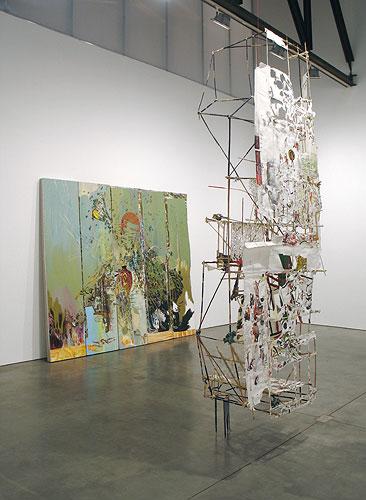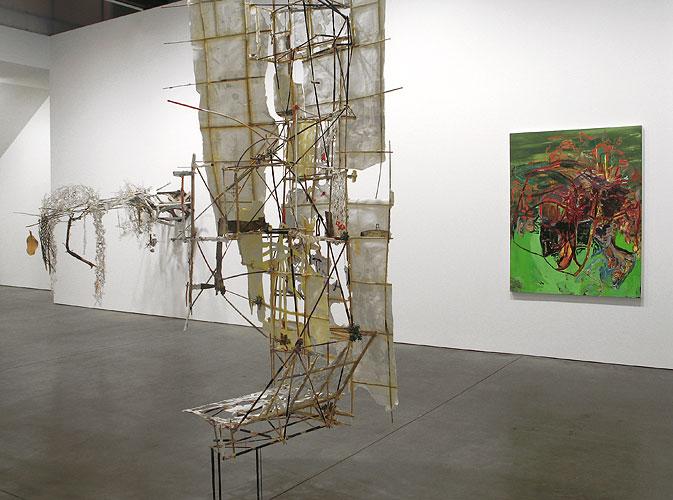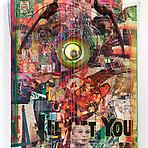Elliott Hundley
March 16 – April 21, 2007
Main Gallery
While the gallery has always focused on work that is content oriented yet not didactic, I now find myself refining my filter; responding most strongly to art in which the content is embedded and less easily decoded. Interesting to me is an artist who is personally imbued and engaged with content and able to create and sustain a life that is full of meaning. I am intrigued by artists who have the confidence to actively engage in seeking the phenomenon of how the making of a work can lead it to the most extreme final conclusion; a mystery, extra-ordinary, and perhaps a work pushed so far as to be on the brink of possible failure. When thinking about these new criteria of experiencing work, Elliott Hundley's art come to mind as exemplary. His ability to access and treat with the same rigor multiple mediums-incorporating sculpture, painting, photography, and performance into two and three dimensional assemblage-with equal levels of openness is inspiring. When the piece leads him there, some works incorporate all these mediums. Yet Hundley is also capable of knowing when to single out a material to make, for instance, an oil painting on board that while passed though the filter of art history, is also liberated and immediate.
It is important to Hundley that he begins a work without a plan, starting with only a thread of an idea that has lingered or found its inception from a previous piece. There is no goal, but simply a material process. It is a working, an addition and subtraction, a layering and peeling, a gluing and tearing, a drawing and blurring, a lying down and wiping away. Then somewhere in the middle, between start and finish, nothing and everything, in relinquishing control, the piece emerges. The process informs him and the materials gestate content. Meaning is set into motion.
Fully aware of his responsibility as a cultural agent, Hundley's practice is marked by a seemingly ceaseless desire to study the world in which he lives. With a deep interest and knowledge of art history and theory, literature, mythology, film, theater, and opera, Hundley's work acts as a constellation of cultural references and signs. Hundley's titles are imbued with historic references and mythological narratives. His use of titles like The Hanging Garden, The Invention of Drawing not only refers to the original tales, but also acts as a reference for how these archetypal stories have already been played out in art history. His intention does not stop there however, he is often most interested in images and narratives that parallel the awesomeness of invention. One of the seven ancient wonders of the world , the Hanging Gardens were thought to be an incredibly elaborate structure built by a Babylonian King for his wife. Layering together an enormous amount of material, the king created a tenuous monument to her. The Invention of Drawing refers to an Ancient Greek story by Pliny the Elder about a young maiden who invents drawing by tracing the outline of her lover's shadow before he leaves on a long journey. In this allegory, drawing is born out of love and the necessity to alleviate the anguish of loss. Hopefully at its best Hundley's work will embody the same qualities that have made these stories timeless-a shared consciousness.
What liberates Hundley from merely creating another assemblage and what allows him to be completely engaged in his process without the need to describe content is his attention to the materials themselves. There are entire photo shoots conceived, directed, performed and then shot by the artist and then dismantled and cut into infinite, tiny pieces. There is a determined intention to produce, for instance, piles red straws painted white, entire paintings made so that a small section can be extracted, ceramics made and found and then disassembled, all to create the raw resources for his working process alongside an endless assortment of carefully chosen found material. Sometimes what can hold a sculpture back is the physical necessity of the labor involved in manifesting the artist's intentions. Hundley seems to free himself through his process, whereby vast amounts of information, content, and labor become inscribed in the raw material itself. This practice of transforming made objects into found objects acts as a kind of reverse alchemy, transforming the artist's own drawings and paintings as well as a vast assortment of everyday items into material charged with potential. This process evinces a radical undermining of traditional hierarchies of value and worth. With rigorous attention and care, everything becomes an important element in the artist's delicate constructions, always on the brink of dissolving and yet stubbornly holding together.
Recently in a conversation with the artist, he recounted a criterion of Henri Matisse: it is important to incorporate multiple psychologies in any one piece so as to dissipate the possibility of the work being biographical. Hundley's work reflects an artist seeking to simultaneously acknowledge a grand narrative while constantly tearing it apart, leaving a generously mysterious space for the viewer.
Andrea Rosen Gallery is pleased to present the first solo gallery exhibition of Elliott Hundley. The artist studied at the Rhode Island School of Design, Skowhegan School of Painting and Sculpture, and UCLA. He lives and works in Los Angeles. Last year he had his first solo exhibition at the Armand Hammer Museum of Art, Los Angeles and his work will again be seen at the Hammer this May as part of "Eden's Edge: Fifteen LA Artists." Hundley's work is found in a number of museum collections including the Museum of Modern Art, New York; the Solomon R. Guggenheim Museum, New York; the Museum of Contemporary Art, Los Angeles, and the Los Angeles County Museum of Art.




